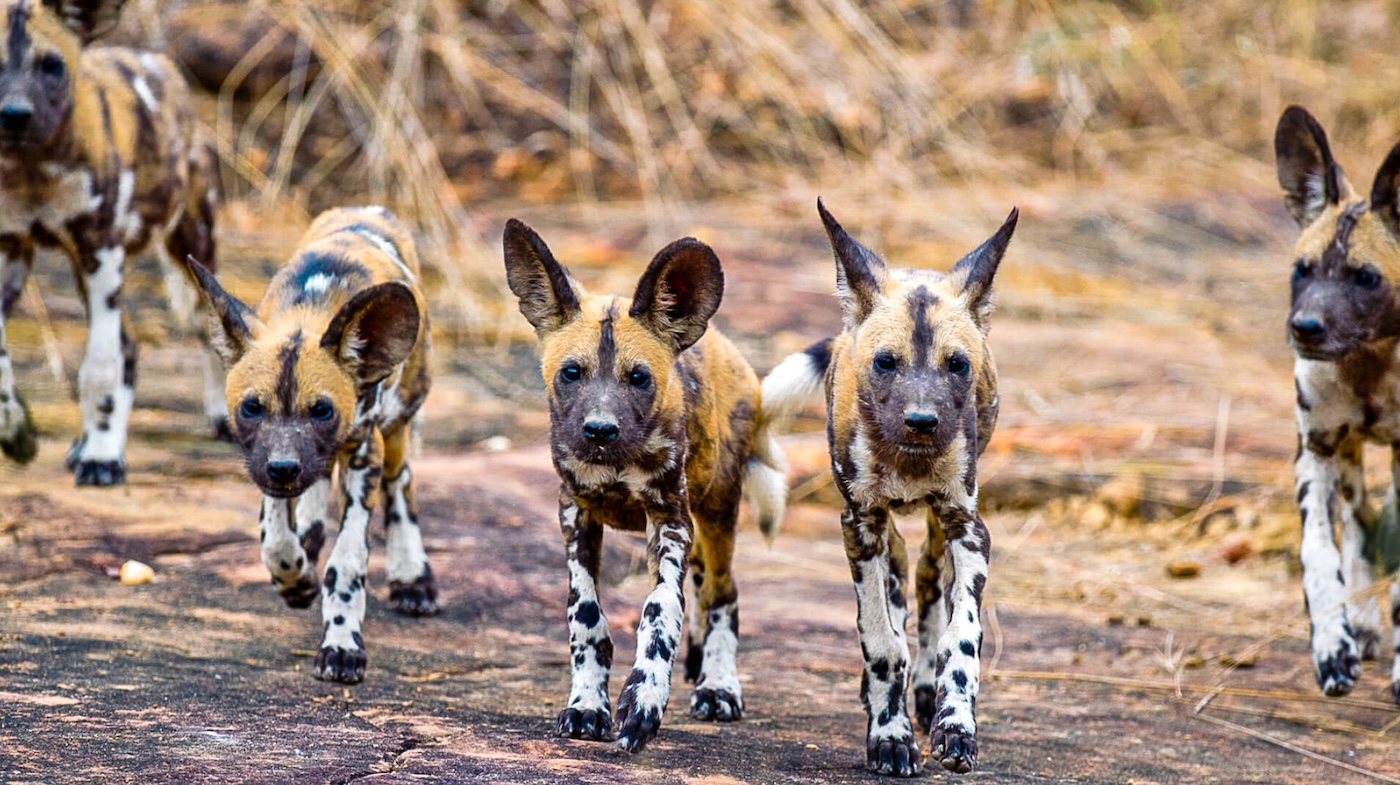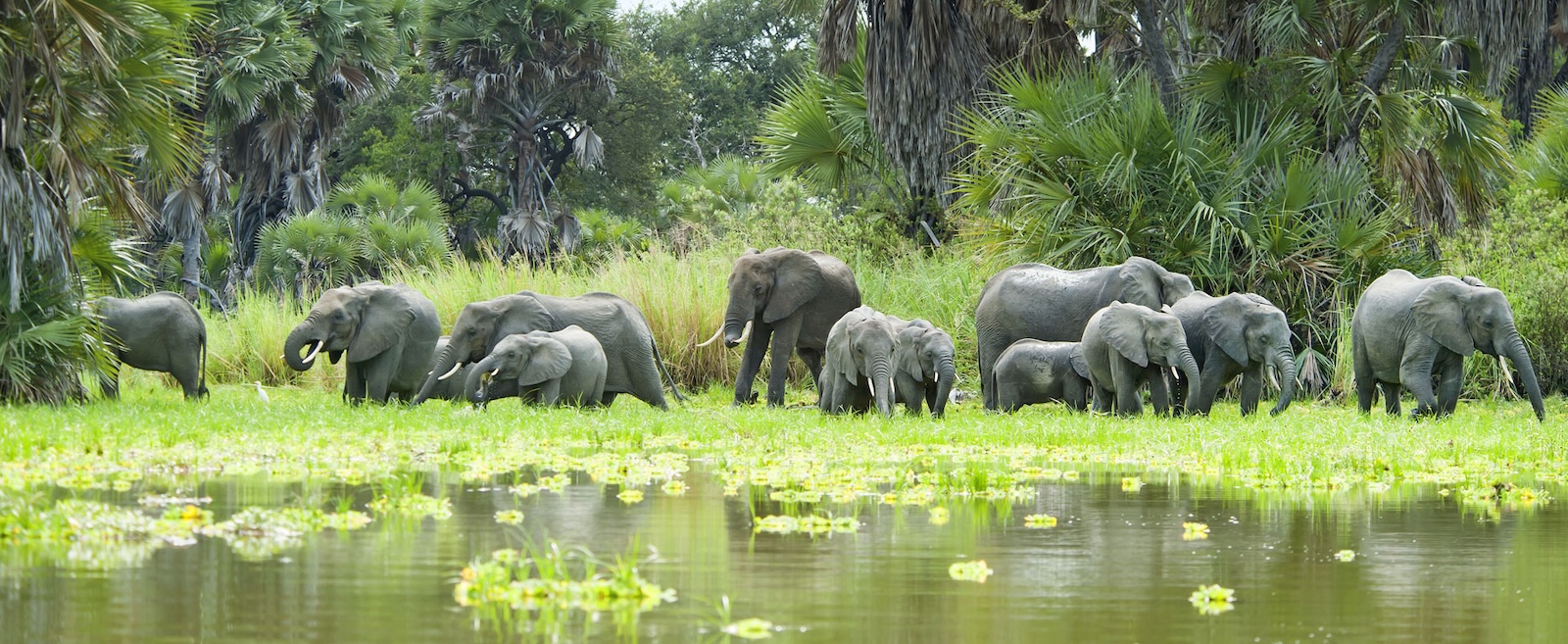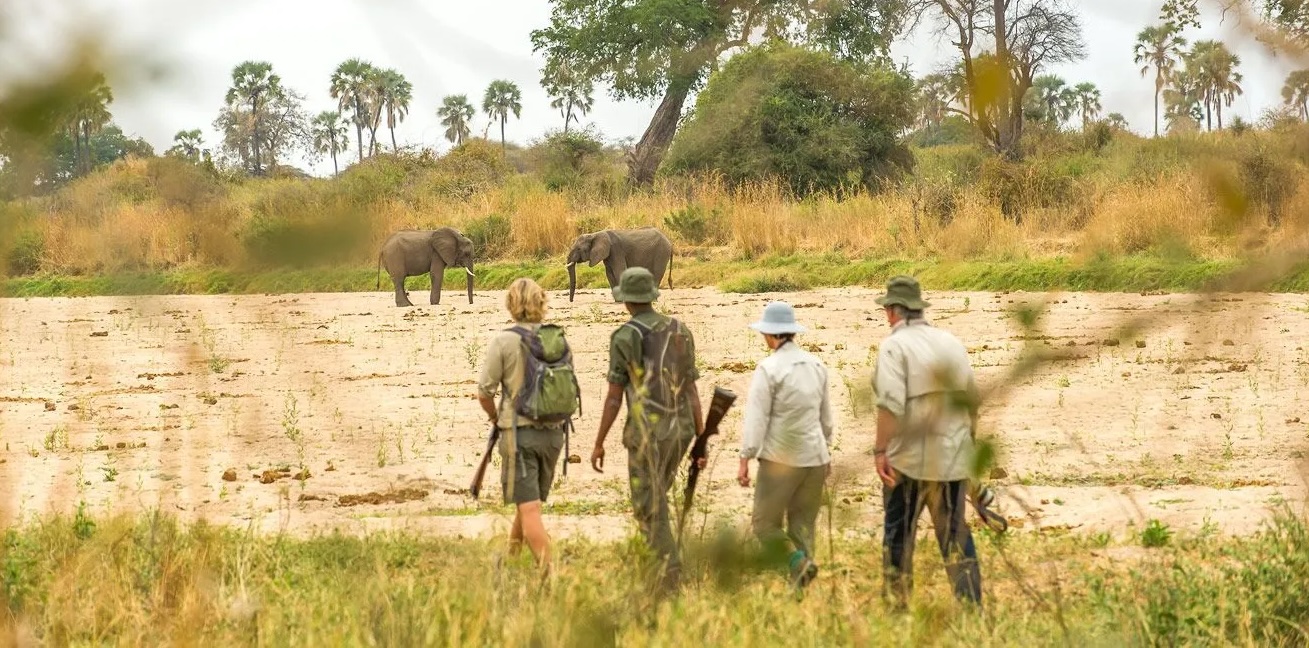Top Southern Tanzania National Parks to Explore
Below is a list of some of the best wildlife parks in Southern Tanzania.
Nyerere National Park
Nyerere National Park is Africa’s largest, spanning 30,893 square kilometers. Once part of the Selous Game Reserve, the name honors Tanzania’s first president. It’s a UNESCO World Heritage Site contender for its pristine ecosystems.
The Rufiji River is the park’s lifeline. It draws elephants, hippos, crocodiles, and large lion prides. Rare African wild dogs and 440 bird species, like Pel’s fishing owl, thrive here.
Nyerere excels in unique activities. Boat safaris along the Rufiji reveal drinking antelopes and basking hippos and crocodiles. Walking safaris uncover tracks and pangolins, while night drives spotlight aardvarks, hyenas and lions.
The dry season (July-November) is ideal for photography. Wildlife concentrates around water sources. A 3-5 night stay maximizes exploration. April and May are not the best time to visit although the park is open to vistors and the prices at the luxury accommodations are at the least.
Fly-in safaris from Dar es Salaam or Zanzibar provide easy access. Safari Desire designs seamless Nyerere adventures with expert guides. Book today for an unforgettable experience. Check out our 3-day safari from Zanzibar to Nyerere National Park.
Ruaha National Park: The Lion’s Stronghold
 Ruaha National Park, at 20,226 square kilometers, is Tanzania’s second-largest. Its rugged wilderness features the Great Ruaha River and baobab-studded hills. It’s a predator’s paradise.
Ruaha National Park, at 20,226 square kilometers, is Tanzania’s second-largest. Its rugged wilderness features the Great Ruaha River and baobab-studded hills. It’s a predator’s paradise.
Ruaha hosts 10% of the world’s lions. You’ll also spot leopards, cheetahs, and hyenas. The park boasts East Africa’s largest elephant herds and rare the sable antelope.
Over 570 bird species call Ruaha home. The endemic Ruaha red-billed hornbill is a highlight.
Game drives in the Ruaha National Park reveal dramatic wildlife interactions. Walking safaris in Ruaha offer intimate views of plants and tracks. Night drives in select camps showcase big cats, genets and bushbabies. The dry season (July-November) is the best for game viewing in Ruaha.
Ruaha’s remoteness ensures exclusivity. Combine it with Nyerere or Mikumi for a full Southern Circuit tour. Safari Desire crafts bespoke Ruaha safaris—reach out to plan yours. Check out our 10-day Southern Tanzania Safari that includes; Mikumi, Nyerere, Nyerere and Udzungwa Mountains National Park.
Mikumi National Park: The Second Serengeti
Mikumi National Park covers 3,230 square kilometers. It’s nicknamed the “second Serengeti” for its open plains. Located 300 kilometers from Dar es Salaam, it’s ideal for budget travelers. With the park fees lower than Serengeti and modestly priced midrange lodges, it is the cheapest safari near Zanzibar and Dar es salaam.
The Mkata Floodplain teems with wildlife. Elephants, giraffes, zebras, and tree-climbing lions roam here. Buffalo, leopards, and wild dogs add to the diversity.
Over 440 bird species, like the lilac-breasted roller, brighten the landscape. Game drives at sunrise or sunset offer prime sightings. Cultural tours to Maasai villages who leave near the park, reveal traditional life of this world famous nomadic tribe; the Maasai.
The dry season is the best time to visit Mikumi (June-October) and this time ensures abundant wildlife. The wet season’s greenery attracts migratory birds. Mikumi suits 2 – 3 day safaris, but we recommend departing Dar es Salaam as early a sposisble because of the long driving distance and speed limits along the Tazam Highway.
We at Safari Desire tailor Mikumi getaways for all budgets. Contact us to plan your accessible adventure.
Udzungwa Mountains National Park: A Hiker’s Haven
Udzungwa Mountains National Park lies in the Eastern Arc Mountains. It’s a biodiversity hotspot of rainforests and peaks. This park is perfect for hikers and nature lovers.
Udzungwa lacks the Big Five but shines with unique wildlife.
Endemic primates, like the Sanje mangabey, roam here. Over 400 bird species, including the crested guinea fowl, thrive.
Sanje Falls, a 170-meter cascade, is the star attraction. A 4-hour hike leads to its base. Other trails, like Prince Bernhard Falls, offer forest pools and views.
The dry season (June-October) suits hiking. The wet season enhances birdwatching. Pair Udzungwa with Mikumi for a safari-hiking blend, or include it in a longer safari that includes other southern parks like Nyerere National Park and Ruaha National Park.
Kitulo National Park: The Serengeti of Flowers
Kitulo National Park sits on a 2,600-meter plateau. It’s called the “Serengeti of Flowers” for its 350 plant species. Its 45 orchid varieties bloom spectacularly from November to April.
This floral display draws butterflies and birds. The endangered blue swallow is a highlight. Large mammals are scarce, but the park’s tranquility appeals to eco-tourists.
Walking safaris immerse you in the plateau’s beauty. Wildflower tours and birdwatching showcase its diversity. The wet season is best for blooms.
Kitulo pairs well with Ruaha for a flora-fauna contrast. Cultural visits to Wakinga communities add depth.


 Southern Tanzania offers a safari experience like no other. Its parks, like Nyerere and Ruaha, feel like Africa’s last frontier. You’ll find vast landscapes with minimal tourist presence. Authentic safari in Africa, that is what you get in the Southern Tanzania Parks.
Southern Tanzania offers a safari experience like no other. Its parks, like Nyerere and Ruaha, feel like Africa’s last frontier. You’ll find vast landscapes with minimal tourist presence. Authentic safari in Africa, that is what you get in the Southern Tanzania Parks. Ruaha National Park, at 20,226 square kilometers, is Tanzania’s second-largest. Its rugged wilderness features the Great Ruaha River and baobab-studded hills. It’s a predator’s paradise.
Ruaha National Park, at 20,226 square kilometers, is Tanzania’s second-largest. Its rugged wilderness features the Great Ruaha River and baobab-studded hills. It’s a predator’s paradise.